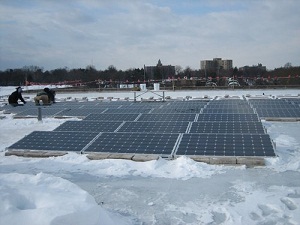Solar week in review
 So the big question is, what solar toys or tools did you get for Christmas this year? Tell Clean Energy Authority about your solar gifts in the comments selection below.
So the big question is, what solar toys or tools did you get for Christmas this year? Tell Clean Energy Authority about your solar gifts in the comments selection below.
Even as the nation curled up for its long winter slumber, the U.S. solar industry kept forging ahead last week with new project announcements all over the spectrum.
For instance, the Department of Energy gave a preliminary announcement that it will offer $50 million to support the development of new solar concentrating technologies at its Nevada National Security Site. The funding will support concentrating photovoltaic installations and solar concentrating technologies that are nearly ready for commercial deployment. DOE will offer details in January or February about the opportunity.
Thanks partly to the government’s decision to extend the ballyhooed 1603 Treasury Grants for large-scale renewable energy projects, another new study shows that the U.S. solar industry is expected to double in growth in 2011 over 2010. That growth will be accompanied by a drop in completed solar installation costs, according to a report by the Lawrence Berkeley National Laboratory.
Helping to sustain that growth the California Public Utilities Commission approved a new program that will drive small to mid-sized renewable energy development, showing that renewable energy growth will not only continue in the large-scale and residential arenas, but across all sectors of the market.
In other California solar industry news, SunReports became the first company in the state to offer a solar thermal monitoring system that meets the strict requirements of the California Solar Initiative Thermal Program. Not everything’s great with solar in the SunShine State, however.
The state has not yet set the generation rate for its net-metered customer generators, which it was supposed to do before the end of 2010.
Across the country, South Carolina’ s Southern Energy Management is monitoring the effectiveness of 60 recently installed residential solar water heating systems through a grant from the South Carolina Energy Office.
Knowing that solar is just part of the answer as the U.S. becomes more sustainable, SolarCity branched out last week with the purchase of Building Solutions, a company that offers energy-efficiency services to building owners. Previously, SolarCity had only offered building owners a way to go solar for less through solar-system leases.
Internationally, the solar market is looking a little more confused. Spain’s cutting solar subsidies by 30—as planned—but some are hoping the country will reconsider. On the other hand, China’s SolarFun announced last week that it would purchase 2,500 megawatts of solar panels from GCL-Poly between now and 2015.
SunPower, which builds the world’s most efficient commercially available photovoltaic panels, made news on two fronts last week. First, it completed what is now the world’s largest operational PV plant, the 85 megawatt Montalto project in Italy. Secondly, it announced a new facility in Malaysia that will allow the company to boost production to 2,000 megawatts annually by 2012.
There is no shortage of new and proposed PV farms that will dwarf the Montalto project, however. A proposed 300 megawatt PV farm outside of Boulder City, Nev., is in the permitting stages with construction expected to be complete in 2014.
While installations continue to be announced every day, some are more notable than others. For instance, the Geological Society of America (GSA) recently unveiled a 65-kilowatt (kW) rooftop solar energy system at its headquarters in Boulder, Colo. That installation will provide up to 35 percent of the building’s energy needs. The North Fork Brewery in Deming, Wash., will also go solar thanks to an 8-kW system, which will start being installed on Dec. 29.
Last week also saw the release of the Northwest Sustainable Energy for Economic Development’s "A Guide to Community Solar: Utility, Private, and Non-profit Development" which helps organizations develop community solar projects, showing readers various project ownership models and the issues that such projects can face.
Image courtesy of NREL.



